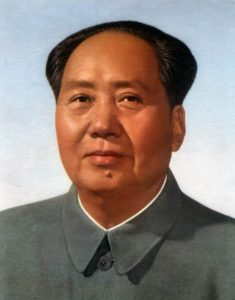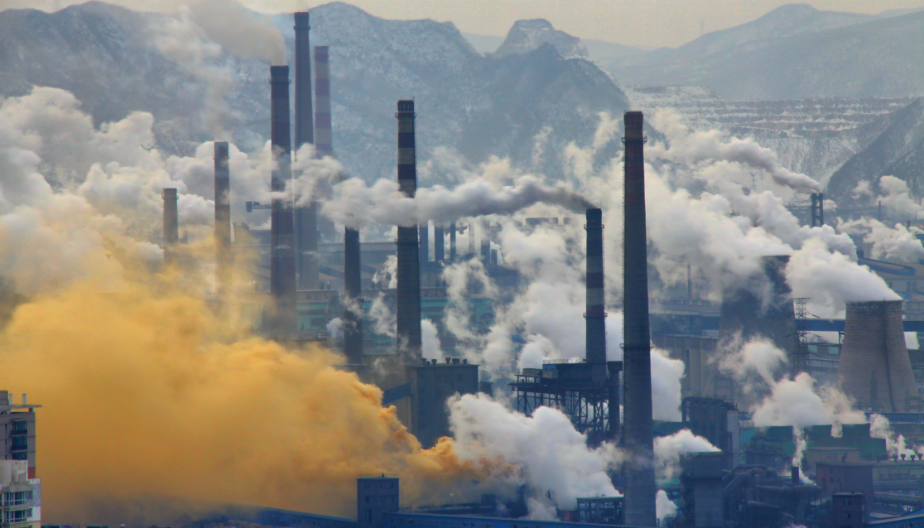
- Summary of the Great Leap Forward campaign:
- Stemmed from the need to compete with the industrial output of Great Britain and the United States, capitalist powerhouses (Economy, 2010, p. 50).
- Major infrastructure projects such as irrigation systems, dams and reservoirs were built to support agriculture; backyard furnaces and factories were built to improve industrial output (Economy,2010, p. 52; Zhang, 1999, p. 64).
-

Mao Zedong, 1962 (Zhang, 1962) 600,000 backyard furnaces were installed to produce iron and steel in less than one year (Zhang, 1999, p. 65).
- The backyard furnaces not only released carbon dioxide, a greenhouse gas, into the atmosphere, but also gaseous forms of the chemical makeup of the ore (Carpenter, 2012, p.12).
- The number of factories in China increased from 160,000 to 310,000 by the end of 1959 (Economy, 2010, p. 52)
- By 1961, 4,000 power stations, 9,000 cement factories and 80,000 farm repair shops had been established and were pumping sulfur dioxide straight into the atmosphere, powered by coal being mined in 59,000 mines (Economy, 2010, p. 52)
- Summary of Deng Xiaopeng’s Economic Reform:
- Mao’s isolationist practices redacted, Open-Door Policy enacted, opening China to foreign corporations and foreign investment and privatization (Jiang, 2015, p. 213; Tantri, 2013, p. 229).
- Growth of private sector (Pong, 2009)
- Establishment of Special Economic Zones (SEZs) (Pomeranz 2016)

- Summary of the Environmental Protection Law, 1979:
- Three Synchronizations: all stages (planning, building, operating) of new and modified construction must take/have preventative pollution measures (Beyer, 2006, p. 192-193)
- Environmental Impact Assessment (EIA): assessment of projected pollution output of new construction projects (Beyer, 2006, p. 192-193)
- Pollution Levy on discharges in exceeding standards: fines issued if levels of pollution released exceed acceptable levels (Beyer, 2006, p. 192-193)
- Summary of the Air Prevention and Control Law, 1987:
- Establishment of emission standards (Laws)
- Right to press charges and fine units which release more emissions than allowed by emission standards (Laws)
- Establishment of pollution monitoring system (Laws)
- Adoption of economic and technological policies to prevent air pollution (Laws)
- Promotion of research to prevent and control air pollution (Laws)
- Measures to plant forests and “green” urban and rural areas (Laws)
- Establishment of building standards to protect environment (Laws)
- Revisions were made in: 1995, 2000, 2014 which tightened standards in an attempt to reduce pollution to lower levels (Laws)

Benxi Steel Industries, Liaoning, People’s Republic of China (Habich, 2013)
- Summary of Cleaner Production Promotion Law, 2002 :
- Pollution remediation projects (World Resources Institute, n.d.)
- Tax incentives for the research and use of clean technologies (World Resources Institute, n.d.)
- Market clean production via pamphlets, guidebooks, educational programs, and media outlets (World Resources Institute, n.d.)
- Summary of the Environmental Protection Law, 2015:
- Enterprises are required to publicly post their emissions levels and the amount of fines they have paid (if applicable) (Clearing the Air on China’s New Environmental Protection Law, 2014, p. 1)
- Enterprises that emit levels of pollution higher than accepted standards will be charged daily fines (an increase from the original 1989 law) (Clearing the Air on China’s New Environmental Protection Law, 2014, p. 2; Zhang, 2014)
- Government officials will be assessed on the completion of their environmental protection goals (Clearing the Air on China’s New Environmental Protection Law, 2014, p. 2)
- The right for any citizen to report environmentally threatening activities by enterprises or individuals (Clearing the Air on China’s New Environmental Protection Law, 2014, p. 2)
- The right for any citizen to report the lack of action taken by an environmental protection governing bodies (Clearing the Air on China’s New Environmental Protection Law, 2014, p. 2)

Citations
Beyer, S. (2006, February 17). Environmental Law and Policy in the People’s Republic of China. Chinese Journal of International Law, 5(1), 185-211. doi:10.1093/chinesejil/jmk002
Carpenter, A. (2012). CO2 abatement in the iron and steel industry. Retrieved October 30, 2016, from https://www.usea.org/sites/default/files/012012_CO2 abatement in the iron and steel industry_ccc193.pdf
Economy, E. (2010). The River Runs Black. Ithaca, NY: Cornell University Press. Chapter 2
Habich, A. (Photographer). (2013). Benxi Steel Industries [digital image]. Retrieved November 29, 2016 https://upload.wikimedia.org/wikipedia/commons/8/85/Benxi_Steel_Industries.jpg
Jiang, Y. (2015, July). Foreign Direct Investment, Pollution, and the Environmental Quality: A Model with Empirical Evidence from the Chinese Regions. The International Trade Journal, 29(3), 212. doi:10.1080/08853908.2014.1001538
Laws. (n.d.). Retrieved November 29, 2016, from http://www.npc.gov.cn/englishnpc/Law/2007-12/12/content_1383930.htm
Pomeranz, K. (2006). Special Economic Zones (SEZS). In J. J. McCusker (Ed.), History
of World Trade Since 1450 (Vol. 2, pp. 706-708). Detroit: Macmillan Reference USA. Retrieved from http://go.galegroup.com/ps/i.do?p=GVRL&sw=w&u=nysl_ce_col gul&v=2.1&it=r&id=GALE%7CCX3447600388&asid=cd06bc7dd04f1 eb204ab27870aa2ac5c
Pong
Tantri, M. L. (2013). Trajectories of China’s Integration with the World Economy through SEZs: A Study of Shenzhen SEZ. China Report, 49(2), 227-250. doi: 10.1177/0009445513 491526
Zhang Z. (photographer). (1962). Mao Zedong [digital image]. Retrieved November 29, 2016 https://en.wikipedia.org/wiki/Maoism#/media/File:Mao.jpg
World Resources Institute. (n.d.). Special Projects. Retrieved November 07, 2016, from http://projects.wri.org/sd-pams-database/china/cleaner-production-promotion-law
Zhang, Z. (1999, Autumn). Rural Industrialization in China: From Backyard Furnaces to Township and Village Enterprises. East Asia. doi:10.1007/s12140-999-0023-y
